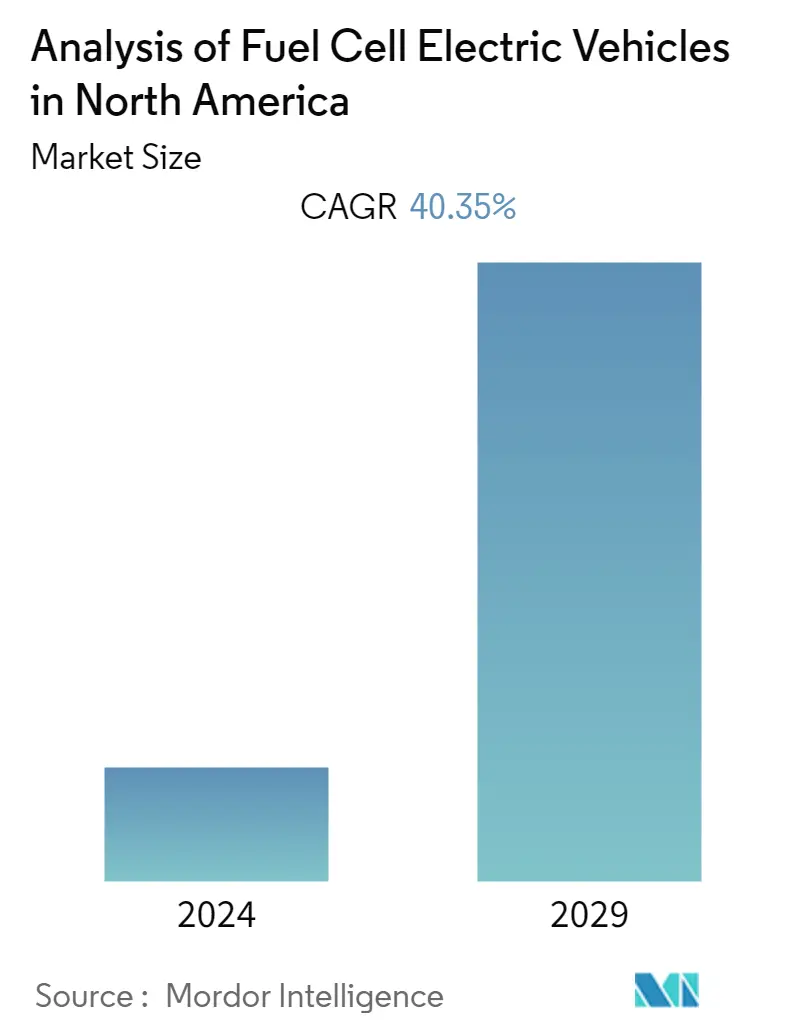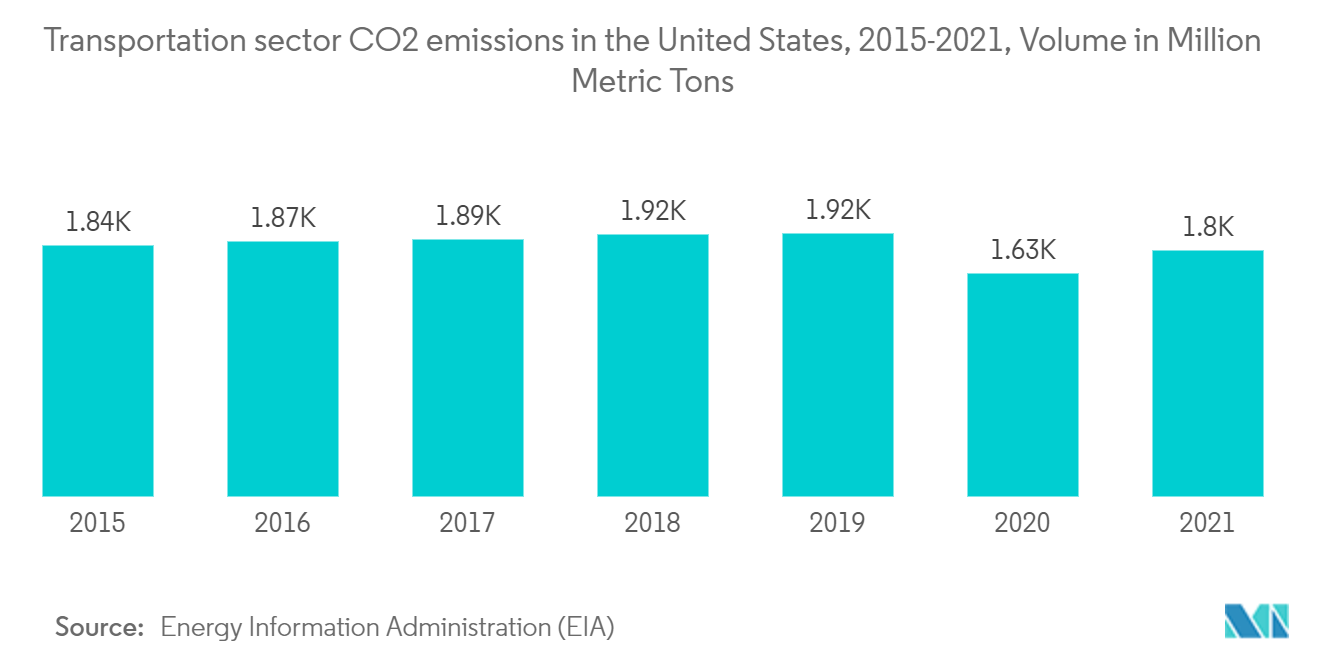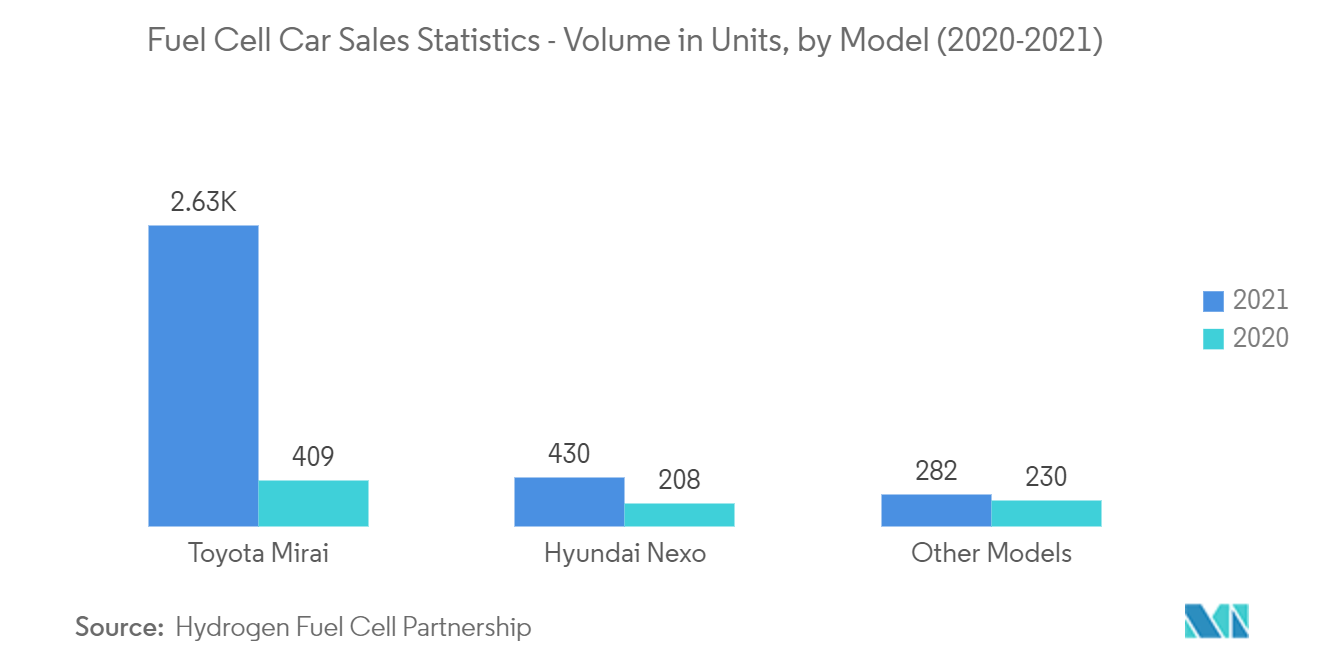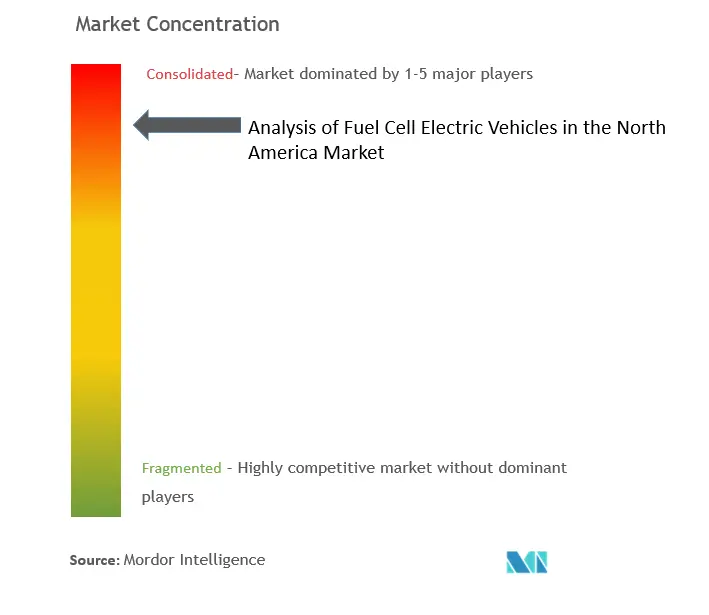North America Fuel Cell Electric Vehicles Market Size

| Study Period | 2019 - 2029 |
| Base Year For Estimation | 2023 |
| CAGR | 40.35 % |
| Fastest Growing Market | North America |
| Largest Market | North America |
| Market Concentration | High |
Major Players.webp)
*Disclaimer: Major Players sorted in no particular order |
North America Fuel Cell Electric Vehicles Market Analysis
North America Fuel Cell Electric Vehicle Market was valued at USD 167.05 million in the current year and It is expected to reach USD 1,791.44 million over the coming five years, registering a CAGR of 40.35%.in terms of revenue during the forecast period.
The COVID-19 pandemic had a significant impact on the North American automotive sector as it affected almost every other industry in the market. During the initial phase of the pandemic, production was halted due to the imposition of lockdowns, creating huge supply chain challenges for component and raw material suppliers as well. Electric vehicle sales remained on the positive side during the pandemic, and they continued to be the same post-COVID-19 as well.
In Q1 2021, the market witnessed a steady recovery after revamping production bases across the United States, which resulted in strong demand for vehicles. In addition, fuel cell vehicles were seen in North America, creating solid impacts on the long-term clean energy mission.
Fuel-cell electric vehicles have no emissions from the tailpipe that contribute to smog or greenhouse gases. This makes hydrogen cell technology one of the key alternatives to diesel and gasoline engines to reduce pollution.
In addition, several automakers are planning to offer fuel cell electric vehicles for sale or lease in a few markets, primarily in California, which holds a few hydrogen refueling stations. Further, the infrastructure for hydrogen is also emerging in other parts of the nation, creating significant opportunities for key automakers to offer fuel cell vehicles. Fuel cell transit buses are currently patrolling the streets of Boston, Flint, Massachusetts, and Michigan, and several stations are being planned for construction in the Northeast and Hawaii. Furthermore, with infrastructure development and technology advancement over the coming years, the adoption of fuel cell vehicles is anticipated to hold high potential during the forecast period.
North America Fuel Cell Electric Vehicles Market Trends
This section covers the major market trends shaping the North America Fuel Cell Electric Vehicles Market according to our research experts:
Shifting Government and Consumer Stance to Provide Momentum
Sustainable transportation, which is often considered the low and zero-emission, energy-efficient, and affordable modes of transport, includes alternative-fuel vehicles such as electric and fuel cells.
The benefits of sustainable transportation in the United States have evolved as a critical factor that might take up a long-term vision by the government. The cost savings on fuel and vehicles has been identified as the key factors to resonate strong demand for these low and zero-emission vehicles. Further, the rise in the adoption of alternative fuel production would invite more employment, ultimately creating jobs with an increased vehicle and battery manufacturing and fuel production.
Government actions have also promoted equivalently to propel the demand for fuel cell technology. For instance, in March 2022, Hexagon Purus was selected by New Flyer as a partner for the hydrogen bus market in North America. The company was selected as a partner for the second year in a row by North America. The company will provide high-pressure hydrogen storage cylinders under the terms of this supply agreement for New Flyer's zero-emission Xcelsior CHARGE H2TM hydrogen fuel cell electric transit buses.
Further, vehicles for sustainable mobility use clean fuel technology, batteries, or both. In addition, the flexible-fuel and dual-fuel vehicles, and vehicles equipped with cutting-edge technologies like fuel cells and hybrid power systems, run on alternative fuels to aid fuel conservation and emissions reduction.
A shift in customer preference toward electric vehicles is an evident sign of future decarbonization and is crucial for the future of charging stations. However, the penetration of EVs is subject to various attributes, including consumer behavior, infrastructure, and certain regional clusters. An increase in electric vehicle sales would proportionally fuel the demand for recharging stations. Prominent players in the market have identified consumer demand and have started focusing on catering to it by offering fast-charging technologies across the country.
Thus, due to the above-mentioned factors, demand for fuel cell vehicles is expected to increase over the coming years.

United States to Register Significant Momentum
Using hydrogen as a fuel has many challenges, including supply, high cost of fuel cell electric vehicles (FCEVs), and infrastructure requirements. Regional governments have addressed this concern by deploying public transport like buses and garbage trucks to gain a certain extinct of customer belief and widen the refueling infrastructure.
Fuel cell vehicles penetrated the US market with 3,341 units of FCEV sold in the United States during 2021 compared to 937 units in 2020, marking a 257% solid Y-O-Y growth rate. This growth in sales was led by key automakers, including Toyota and Hyundai.
In addition, Toyota Mirai alone made 2,629 sales in the United States, with 427% Y-o-Y growth from 499 unit sales in 2020. Similarly, Hyundai Nexo registered 430 units of sales with Y-o-Y growth of 107% from 208 units in 2020. Other models registered a Y-o-Y growth of 23%, with 282 units sold in 2021. Moreover, Toyota Mirai holds the largest market share for fuel cell vehicles in the United States, with a nearly 79% market share.
Further, the government seeks active participation in revamping the charging infrastructure network for fuel cell vehicles across the United States in order to keep the mission prospering. Further, manufacturers are investing in fuel cell technology and announcing their latest lineup. For instance,
- In November 2022, HVS (Hydrogen Vehicle System) announced its plan to launch 40 tons of heavy-duty vehicles made of the hydrogen fuel power train to resonate strong potential for green emission missions.
- In May 2022, Daimler Buses announced that it aims to offer CO2-neutral vehicles locally based on batteries and hydrogen in every segment by 2030, initially focusing on Europe and America. Daimler Buses will not invest in Euro VII technology, instead focusing on both battery-electric and hydrogen-based technologies, in line with the dual-track strategy of its parent company Daimler Truck.
Thus, owing to the demand for green transportation and the government's stance, demand for these vehicles is expected to remain positive during the forecast period.

North America Fuel Cell Electric Vehicles Industry Overview
None of the players has started offering any of its product lines in the fuel cell vehicle, which marks the early stage of development of the market. Companies including Toyota Motor Corporation, Hyundai Motor Company, Honda, Nikola Corporation, and Daimler AG are some of the key potential players anticipated to tap the fuel cell electric vehicle market in the coming years under the passenger car segment.
Moreover, several strategies have been adopted by the players to robust their offering over the past years, including Toyota launching Mirai LE and XLE in 2022 to resonate strong demand for fuel cell vehicles. In addition, Hyundai Nexo has also rolled into the US market, which came as a key factor in fueling the demand across North America.
North America Fuel Cell Electric Vehicles Market Leaders
-
Toyota Motor Corporation
-
Hyundai Motor Company
-
Stellantis NV
-
Nikola Corporation
-
Honda Motor Co., Ltd.
*Disclaimer: Major Players sorted in no particular order

North America Fuel Cell Electric Vehicles Market News
November 2022: Volkswagen AG announced its plans to build hydrogen cars for the American and European markets. The company is presently working on making competitive pricing for fuel cells, making it a cheaper option than its other offerings.
May 2022: Hyundai Motor Company announced its plan to ramp up its US commercial vehicle market entry with XCIENT Fuel Cell trucks at the 2022 Advanced Clean Transportation (ACT) Expo, where it displayed its 6x2 XCIENT Fuel Cell tractor and 6x2 XCIENT Fuel Cell rigid truck.
North America Fuel Cell Electric Vehicles Market Report - Table of Contents
1. INTRODUCTION
1.1 Study Assumptions
1.2 Scope of the Study
2. RESEARCH METHODOLOGY
3. EXECUTIVE SUMMARY
4. MARKET DYNAMICS
4.1 Market Drivers
4.2 Market Restraints
4.3 Porters Five Force Analysis
4.3.1 Threat of New Entrants
4.3.2 Bargaining Power of Buyers/Consumers
4.3.3 Bargaining Power of Suppliers
4.3.4 Threat of Substitute Products
4.3.5 Intensity of Competitive Rivalry
5. MARKET SEGMENTATION (Market Size Value in USD million)
5.1 By Vehicle Type
5.1.1 Passenger Car
5.1.2 Commercial Vehcile
5.2 By Country
5.2.1 United States
5.2.2 Canada
5.2.3 Rest of North America
6. COMPETITIVE LANDSCAPE
6.1 Vendor Market Share
6.2 Company Profiles *
6.2.1 Toyota Motor Corporation
6.2.2 Hyundai Motor Company
6.2.3 Tesla Motors Inc.
6.2.4 Volkswagen AG
6.2.5 Daimler AG
6.2.6 Nikola Corporation
6.2.7 Stellantis NV
6.2.8 Honda Motor Co. Ltd
7. MARKET OPPORTUNITIES AND FUTURE TRENDS
North America Fuel Cell Electric Vehicles Industry Segmentation
A vehicle that is running on alternative fuel technology like hydrogen is considered a fuel cell vehicle. These vehicles are more energy efficient compared to electric vehicles. The report offers a comprehensive analysis of the ongoing development in the fuel cell vehicle landscape with challenges and opportunities for OEM.
Analysis of Fuel Cell Electric Vehicle in North America Market is segmented by vehicle type and by Country.
Based on the vehicle type, the market is segmented into passenger cars and commercial vehicles,
Based on the country, the market is segmented into the United States, Canada, and the Rest of North America.
For each segment, the market sizing and forecast have been done based on the value (USD Million).
| By Vehicle Type | |
| Passenger Car | |
| Commercial Vehcile |
| By Country | |
| United States | |
| Canada | |
| Rest of North America |
North America Fuel Cell Electric Vehicles Market Research FAQs
What is the current North America Fuel Cell Electric Vehicles Market size?
The North America Fuel Cell Electric Vehicles Market is projected to register a CAGR of 40.35% during the forecast period (2024-2029)
Who are the key players in North America Fuel Cell Electric Vehicles Market?
Toyota Motor Corporation, Hyundai Motor Company, Stellantis NV, Nikola Corporation and Honda Motor Co., Ltd. are the major companies operating in the North America Fuel Cell Electric Vehicles Market.
Which is the fastest growing region in North America Fuel Cell Electric Vehicles Market?
North America is estimated to grow at the highest CAGR over the forecast period (2024-2029).
Which region has the biggest share in North America Fuel Cell Electric Vehicles Market?
In 2024, the North America accounts for the largest market share in North America Fuel Cell Electric Vehicles Market.
What years does this North America Fuel Cell Electric Vehicles Market cover?
The report covers the North America Fuel Cell Electric Vehicles Market historical market size for years: 2019, 2020, 2021, 2022 and 2023. The report also forecasts the North America Fuel Cell Electric Vehicles Market size for years: 2024, 2025, 2026, 2027, 2028 and 2029.
Analysis of Fuel Cell Electric Vehicles in North America Industry Report
Statistics for the 2024 Analysis of Fuel Cell Electric Vehicles in North America market share, size and revenue growth rate, created by Mordor Intelligence™ Industry Reports. Analysis of Fuel Cell Electric Vehicles in North America analysis includes a market forecast outlook to 2029 and historical overview. Get a sample of this industry analysis as a free report PDF download.



